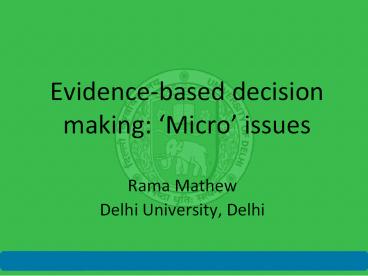Evidence-based decision making: - PowerPoint PPT Presentation
1 / 21
Title:
Evidence-based decision making:
Description:
Learning occurs when students are thinking, problem solving, ... students language learning processes and the kind of fine-tuned support they need, ... – PowerPoint PPT presentation
Number of Views:109
Avg rating:3.0/5.0
Title: Evidence-based decision making:
1
Evidence-based decision making Micro issues
- Rama Mathew
- Delhi University, Delhi
2
Micro issues in evaluation
- Evaluation in education functions at two levels
- Macro level decisions about pass/fail,
attendance, teacher-pupil ratio, mid-day meals,
teacher qualifications etc. - Product oriented, high-stakes, summative
- Micro level how are students progressing in the
classroom? The kind of support needed based on
feedback - Process oriented, low stakes, formative
3
Why we need to do FA
- FA supports and assists learning it provides
feedback and correctives at each stage in the
teaching-learning process - FA can tell what students know and can do, and
can do with some difficulty and therefore
instruction can be modified accordingly
4
Who is involved in FA?
- The teacher and students
- Because both are part of the teaching-learning
process - If students are to develop into lifelong,
independent, self-directed learners, and take
ownership of their learning, they need to be
included. This way they will be motivated to
learn.
5
FA is assessment for learning
- Assessment for learning (AfL)
- Assessment of learning (AL)
- Monitoring learner progress is AfL
6
What AfL is not
- More frequent summative assessments
- All testing a teacher does in the classroom
- Filling up forms on how good each student is on
various dimensions - Labelling certain students or excluding them from
future learning experiences - A test. FA produces not a score but an insight
into student understanding - Something that interferes with students learning
7
What is learning?
- Learning occurs when students are thinking,
problem solving, constructing, transforming,
investigating, creating, analyzing, making
choices, organizing, deciding, explaining,
talking and communicating, sharing, representing,
predicting, interpreting, assessing, reflecting,
taking responsibility, exploring, asking,
answering, recording, gaining new knowledge, and
applying that new knowledge to new situations.
Cameron, Tate, Macnaughton and Politano 1998,
p.6)
8
Definition of AfL
- Assessment for Learning is part of everyday
practice by students, teachers and peers that
seeks, reflects upon and responds to information
from dialogue, demonstration and observation in
ways that enhance ongoing learning. - (AfL experts, Dunedin New Zealand, 2009)
9
Keeping Learning on Track (ETS 2010)
- The idea is of students and teachers to use
evidence .to adapt teaching and learning to meet
immediate learning needs minute-by-minute and
day-by-day
10
Any assessment involves four activities
- Designing opportunities to gather evidence
- Collecting evidence
- Interpreting it
- Acting on interpretations
11
Key strategies for doing AfL
- Sharing learning expectations (clarifying
intentions, and criteria for success) - Questioning (to engineer effective classroom
discussions, questions that elicit evidence of
learning and making inferences from that
evidence) - Feedback
- Self-and peer-assessment
12
Processes involved in FA
self-/peer and teacher assmnt through spontaneous
and planned obsrvn of individual students/pairs/
groups, asking questions, maintaining records of
how students progress from one activity to another
Assess status of goals
Present state of learners
ability
Action taken by teacher/ learner to bridge the
gap
Set new goals by negotiating
13
(No Transcript)
14
- Monitoring progress is research-based teaching
(Stenhouse 1975141) and is the business of the
teacher.
15
Challenges and issues
- Assessment reforms would have to address all
three components simultaneously, i.e. teaching,
learning and assessment. A vision of a
whole-curriculum reform should be conceptualised,
concretised and supported. - Physical and infrastructural facilities
16
Challenges and issues
- Need for orientation in pre-service and
in-service teacher workshops to the
characteristics of FA and how it could be
translated into classroom processes - Teachers need time and space to develop a sense
of ownership and to articulate and critique their
own implicit constructs and interpretations.
17
Future directions
- Case studies to be carried out that look closely
at what strategies teachers adopt to monitor
progress, students language learning processes
and the kind of fine-tuned support they need,
especially low-achievers.
18
Future directions
- There are very few research-based, empirical
accounts by teachers themselves of how they
monitor students progress in their classrooms
it is usually the assessment expert who does
research.
19
Can all learning be evidence based?
- Not everything that can be counted counts, and
not everything that counts can be counted. - Albert Einstein
20
References
- Assessing ESL in South Asia. In A. J. Kunnan
(Ed.) The Companion to Language Assessment,
California John Wiley Sons, Inc.,2014, DOI
10.1002/9781118411360. wbcla104. - Monitoring progress in the classroom. In A. J.
Kunnan (Ed.) The Companion to Language
Assessment, California John Wiley Sons, Inc.,
2014, DOI 10.1002/9781118411360.wbcla073
(Co-author M. Poehner).
21
Thank you mathewrama_at_gmail.com































